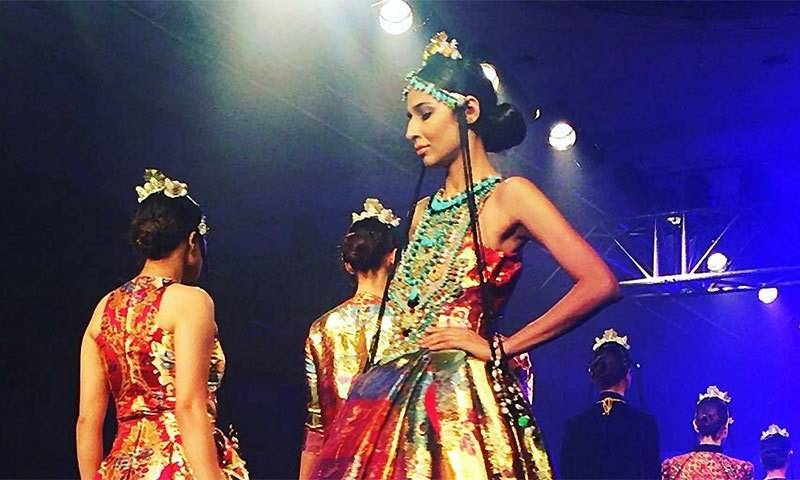This week I had the utter displeasure of coming across a new bridal shoot done for a famous designer and the divided discourse that popped up in response to this controversial campaign. This particular fashion designer is the object of my wrath today as his campaign depicts all that is wrong with this society. He is hailed as being so very “fashion forward” in his approach to apparel and is well known in the fashion industry and I personally admire his creativity, until I came across this disaster that he called a campaign. One fine morning this man woke up and decided to hire a fair skinned supermodel, paste a tonne of dark make up on her face and hands, dresses her up in pretty bridal dresses and takes a bunch of photos to splash across all leading fashion magazines, and call it all bold and futuristic.
The campaign features a dark-skinned girl (fake-dark), and on the face of it (pun intended) it is promoting that dark is also beautiful (still fake-dark), and it’s a “bold” step because designers almost never pick dark-skinned models (that’s because there aren’t any and neither was this one!). My question to this man is: Did you not find a single dusky complexioned beautiful girl in the entire of Pakistan that you thought it was okay to paint a top model darker, and defeat the point you were trying to make? If the true purpose was to embrace natural beauty, it should have been natural.
He goes on to say, “This has been a huge concept for me that I always wanted to articulate. Its really close to my heart and I wanted to make sure that it was done right. This shoot’s sole purpose is to have people understand that their colour is the right colour; that beauty standards are not to be stereotyped.” Sorry to break it to you mister, you managed to achieve quite the opposite, stereotyping the models (there’s a male counterpart too and his very fair face has been darkened with make up as well) by placing them in a dilapidated rural setting. Yes because poor people are dark skinned- that’s the divide and it’s how it is supposed to be portrayed, and the divide was reinforced (at least the clothes were pretty). So no sir, it wasn’t done right at all. This is no better than the white coloniser stereotyping the dark savage oriental.
We must go deeper into why I and many other people find this ‘black facing’ so wrong. Beauty standards have constantly undergone a metamorphosis over time. We are a beautiful race featuring a range of colours and tones and so the debate is more complicated than the racial discourse that is dominant in the west. And yet instead of embracing our unique features, we shape ourselves to fit into the mold of Eurocentric beauty. Whitewashing, obsessing over fairness creams and exploitation of this despicable desire to be “white” is all too commonplace in Pakistan. And while we accept that this is unfortunate and wrong and women should embrace their originality, the same reasoning holds true for ‘black facing’ oneself into a stereotype of the oppressed class.
Not so long ago there was a Pakistani television series that featured an actress who was made dark using make up and it revolved around how unfortunately she was treated because of the color of her skin. While the take home message might be a positive one where they seek to address the discrimination and change society’s perception on colour, it was done wrong because of the embarrassing way her skin tone had been changed to make her look ‘unappeasing’. The fashion and TV industry, even when they try to make a change, reinforce the status quo by black facing- because none are really progressive enough to give a girl who is not fair complexioned a chance. The solution, to darken a fair girl, is problematic. It reinforces that a fair person can be made dark (and by stereotype exotic), but a dark skinned person can’t (nor can they model in their own category). These cheap theatrics must stop and to change society’s perception truly the industry needs to include real women with dark tones. What we’re doing today is eerily close to what Hollywood was saying during the 1930s and 1940s, when white actresses and actors taped the corners of their eyes into slants to portray Asian characters, or white actors used greasepaint or shoe polish to blacken their skin and exaggerate their lips to complete the transformation into ‘Happy go lucky blackies’.
In this day and age of photoshop, airbrushing, misappropriating body features, we have to find originality or some hint of it somewhere to be able to relate to the visual messages being fed to us constantly. The divide between what is fake and what is real has thinned out to the point where we forget realistic expectations of our bodies and beauty.
Fashion must be a holistic representation of society at large. While African American women have only recently made it into the mainstream fashion and entertainment industry, let us not wait fifty years to promote and encourage dark skinned women to enter the Pakistani entertainment industry so there is non-discriminatory representation of beautiful women with darker skin tones. And words of advice till we can really accept them; lets put away that dark make up, shall we?






